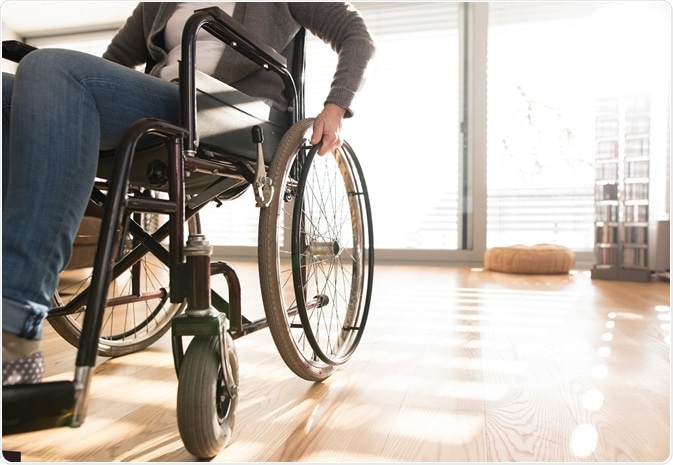Tetraparesis, or quadraparesis, is a condition in which all four limbs are weak. Several causes exist, many of which are treatable.

Credit: Halfpoint/Shutterstock.com
In some patients with tetraparesis, the limbs may lack voluntary motor control, while in other patients, some limbs or parts of limbs may be paralyzed but others function normally. The cause of the weakness is a partial interruption of the nerve impulses passing along the spinal cord, hence the muscles supplied by these nerves do not function normally.
A full neurologic examination is thus essential to identify the pattern of weakness and the involved nerves. This will usually be followed by imaging studies to locate the area of damage causing the sensory and motor weakness. This, in turn, will determine the treatment approach.
Causes
Congenital tetraparesis
Some patients have tetraparesis due to congenital or birth problems. Among these, cerebral palsy (or spastic tetraparesis) is the most common reason.
Acquired tetraparesis
- Spastic tetraparesis may also result from neurologic degeneration
- Spinal trauma leading to cord damage, as in intervertebral disc rupture, a fall, or a motor accident
- Acute myopathies
- Conversion disorders and locked-in syndrome
- Evolving flaccid paralysis may occur due to myelopathies involving the spinal cord itself or peripheral nerves.
- Evolving flaccid paralysis due to neuropathies
Causes of tetraparesis which affect the spinal cord include:
- Cord compression by a bulging or ruptured intervertebral disc, tumor, hematoma, abscess or other mass lesion, or stenosis of the spinal column
- Transverse myelitis affecting the whole of one transverse section of the cord
- Encephalitis involving the brainstem
- Necrotizing myelopathy
- Infections such as polio, enterovirus or flavivirus infections
Neuropathies which can cause evolving flaccid paralysis include:
- Guillain-Barre syndrome and its variants
- Secondary neuropathies due to metabolic dysfunctions as in diabetes, porphyria, Lyme disease, uremia, some poisonings, autoimmune vasculitides, paraneoplastic syndromes and critical illnesses
- Neuromuscular junction diseases such as myasthenia gravis, botulism, some envenomations
Symptoms and signs
The presence of acute hypotonia and hypo- or areflexia along with tetraparesis may signal a lesion or involvement of the lower central nervous system, i.e., the spinal cord.
The presence of spastic muscles and high muscle tone shows upper motor neuron involvement, i.e., of the brain. In cerebral palsy, both upper and lower limbs are symmetrically and intensely affected with a floppy neck, dysarthria and respiratory difficulties in severe cases.
The occurrence of rapidly progressing tetraparesis may signal other conditions. In most cases, it is ascending upwards from the lower limbs, but it may sometimes be a descending weakness. The reflexes are affected early in peripheral neuropathies, but are typically spared in diseases of the neuromuscular junctions and in myopathies until severe weakness begins to appear.
In most cases, the patient finally presents with severe muscle weakness, poor or absent deep tendon reflexes, and in some cases, involvement of the respiratory, brainstem and ocular muscles. Symmetry of paralysis, the involvement of extraocular muscles, sensory signs, and autonomic nervous system involvement are commonly seen.
The clinical features along with some diagnostic neurological and electromyographic (EMG) tests help to confirm the condition. Serum electrolytes, serum creatine kinase, and cerebrospinal fluid (CSF) studies are all useful in differentiating various conditions, as are muscle and nerve function testing such as the nerve conduction studies and EMG testing.
Management of tetraparesis
Once the underlying cause and extent of nerve damage is identified, various methods of treatment may be employed, such as:
- Surgical removal of intervertebral discs which are bulging into and compressing spinal nerves, as well as of other surgical causes of cord compression
- Treatment of specific metabolic derangements and post-inflammatory conditions
- Physical therapy to keep the muscles strong and flexible while nerve recovery is happening
- Assistive devices such as canes or wheelchairs to help carry out daily functions effectively while there is motor impairment preventing normal movement
- Bowel and bladder care is essential as these functions are often affected
- Surgical tendon release, selective dorsal rhizotomy, injections of GABAB receptor agonist or acetylcholine release inhibitor, and physical therapy are some of the methods used to treat children with severe cerebral palsy
Further Reading
Last Updated: Feb 27, 2019